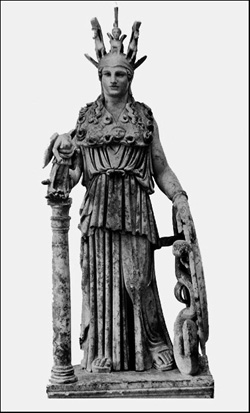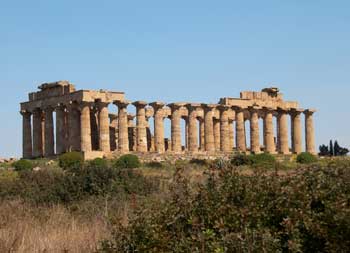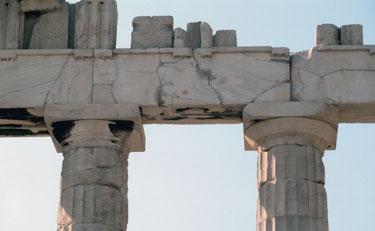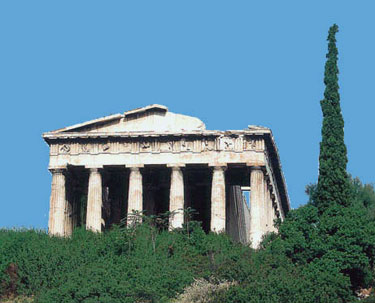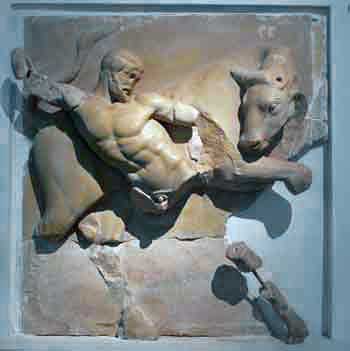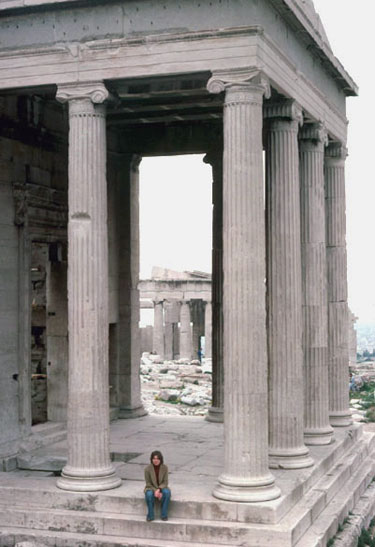
The Role of the Temple
Most religious buildings today are intended for congregational worship, where groups of people get together on a regular basis to celebrate their god, reaffirm their faith and receive spiritual comfort. Ancient Greek temples were rarely used this way. They were meant to serve as homes for the individual god or goddess who protected and sustained the community. It was the needs of the gods that were most important. They controlled the forces of nature— the sun and rain, which nourished their crops, and the winds that drove their ships. Although generally benevolent, the gods could be quite capricious and were liable to turn against the community— so it was in everyone's interest to make sure that they should feel relaxed and at home. Their houses were the finest, equipped with a staff of servants to look after their every need. They received daily offerings of food and drink along with a proper share of the harvest as well as a share in the profits of any trading or military activity.
The god or goddess was represented by a cult image— usually a seated or standing statue— which occupied the central place in the temple. In the early days they would have been made of wood but, over the years, more permanent and costly materials were preferred— stone or cast bronze. The finest, such as the great statues of Zeus at Olympia or Athena from the Parthenon in Athens (both by the Athenian sculptor Phidias) were of crystelephantine, a combination of gold and ivory. The statue of Zeus was considered one of the Seven Wonders of the ancient world.
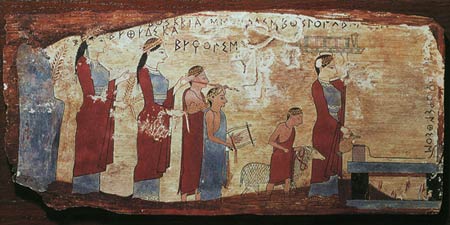
Painted scene (plaster on wood) showing a sacrifice (Pitsa 6th century BC)
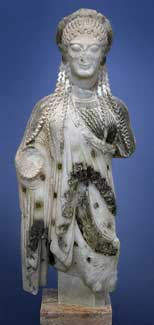 The temple building normally stood inside a sacred enclosure known as the temenos— reflecting the rural origins of most cults. It generally included a natural feature such as a spring, a grove of trees or a cave which was the actual focus of public worship. It was the only part of the complex open to the general public— ordinarily, only priests were admitted into the divine presence to perform the necessary rituals on behalf of the community. Private groups and individuals were encouraged to contribute to the upkeep of the temple through offerings and dedications but otherwise, public participation was limited to taking part in religious festivals and processions. These culminated in lavish sacrifices of prime livestock at the god's altar which stood within the temenos but outside the temple proper.
The temple building normally stood inside a sacred enclosure known as the temenos— reflecting the rural origins of most cults. It generally included a natural feature such as a spring, a grove of trees or a cave which was the actual focus of public worship. It was the only part of the complex open to the general public— ordinarily, only priests were admitted into the divine presence to perform the necessary rituals on behalf of the community. Private groups and individuals were encouraged to contribute to the upkeep of the temple through offerings and dedications but otherwise, public participation was limited to taking part in religious festivals and processions. These culminated in lavish sacrifices of prime livestock at the god's altar which stood within the temenos but outside the temple proper.
These were occasions of great public celebration highlighted by feasts, athletic competitions and dramatic productions. The god or goddess was presented with gifts of jewellery and fine garments along with tableware and cutlery of silver and gold. Statues of young men (kouroi) and young women (korai) were dedicated to the deity as votive offerings and evidence of personal piety. The kore on the left was found on the Acropolis in Athens and dates to the late sixth century BC. Finally, the citizenry gathered in front of the temple to offer their collective prayers for abundant crops and increased flocks. They prayed for success in any venture that their city might have been undertaking— a war, a trading expedition or the foundation of a new colony.
The Peripteral Temple
The most important architectural innovation of the Greeks was the external colonnade (pteron) which emerged sometime in the seventh century BC. It formed a sort of curtain around (peri-) the temple— solid but transparent— screening the sanctuary and the cult image from the outside world. Columns had been used for thousands of years in the ancient world but primarily inside buildings, to support the ceilings of large halls or to line the inside of open courtyards. The first appearance of an external colonnade is at Lefkandi on the island of Euboea where about fifty wooden posts were used to surround some sort of ceremonial structure (right), a temple or the shrine to the local hero (heroön).
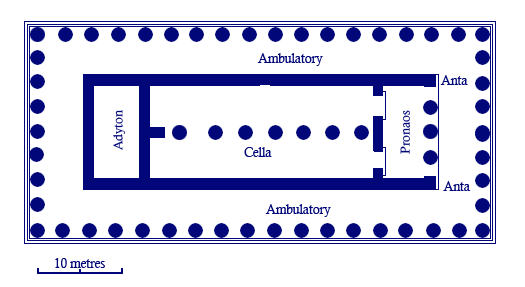
Paestum. Plan of the first Hera Temple
Typically, the layout of the temple was based on the megaron, a house form that had been around since the Bronze Age. Essentially it consisted of a rectangular room (the cella or naos) with projecting walls (antae) framing a porch (pronaos) at one end. Normally there was a screened off area at the rear of the building, the adyton, to which only the priests were admitted. The roof of the porch was supported by two or more columns in antis 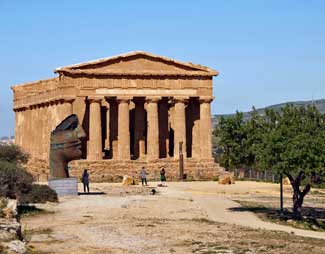 (between the antae). In some temples there was a ‘false’ porch (opisthodomos) at the rear of the temple to provide balance. The building stood on top of a low stepped platform (stylobate). As a rule, the external colonnade contained twice as many columns along the long side as there were along the short side plus one— so, if there were six columns at the ends there would be fourteen columns along the sides. The columns consisted of three elements— the base, the shaft and the capital. They supported an entablature which was essentially a translation into stone of the wooden beams which held up the eaves of the low, pitched roof.
(between the antae). In some temples there was a ‘false’ porch (opisthodomos) at the rear of the temple to provide balance. The building stood on top of a low stepped platform (stylobate). As a rule, the external colonnade contained twice as many columns along the long side as there were along the short side plus one— so, if there were six columns at the ends there would be fourteen columns along the sides. The columns consisted of three elements— the base, the shaft and the capital. They supported an entablature which was essentially a translation into stone of the wooden beams which held up the eaves of the low, pitched roof.
The earliest versions such as the hero-shrine at Lefkandi were built out of wood but within a short time stone was being used throughout. Its permanence was considered more appropriate to the eternal nature of the immortal gods. This involved the translation of (generally inappropriate) carpentry techniques to the new art of stonemasonry. Little account was taken of the different qualities of the two media— stone lintels and beams are not as flexible as wooden ones yet the amount of weight they had to bear was enormously increased. Therefore, the columns had to be placed much closer together making the entire structure seem quite massive and solid-looking.
The ancient authors divided Greek architecture into two principal orders, the Ionic and the Doric— the former evolved in Asia Minor and the latter in the Peloponnese. To these might be added two other, more localized styles, the Aeolic from the northern Aegean and the Corinthian. The principal distinctions among the various orders lay in the treatment of the column and entablature.

The Parthenon (the epitome of the Doric Order)
The Doric Order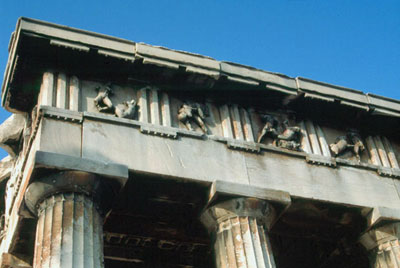
The Doric order was the predominant type of temple on the Greek Mainland and among the Western Greeks of Sicily and southern Italy. The essential elements of this rather severe style had been put into place by the middle of the sixth century BC. The fluted columns had no bases and only very simple capitals. They supported an entablature which consisted of the architrave (stone cross beams) and the frieze, which was essentially a decorative element composed of alternating metopes (stone panels) and triglyphs (carved, upright bars in groups of three). The example above comes from the Hephaistion in the Athenian agora. Above the entablature was a low, pitched roof decorated with moulded edges known as cornices. The triangular space at each end of the roof was known as the pediment and was often decorated with sculptures.
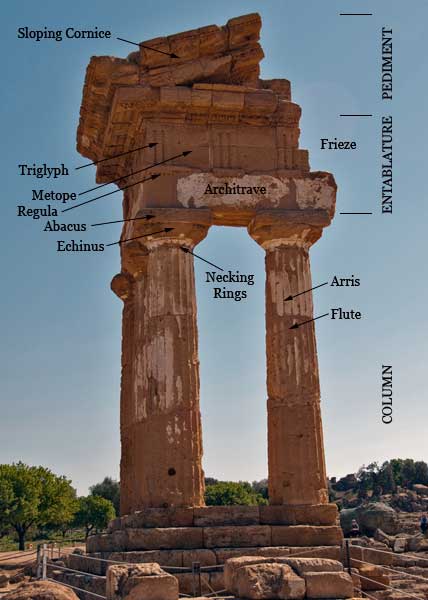
The Main Elements of the Doric Order (Temple of the Dioscouri at Agrigento)
In Doric temples the columns almost invariably stood directly on the floor, tapering upwards towards the roof. They were composed of a number of superimposed drums, held together by dowels of wood or bronze, and were generally fluted (i.e. cut with concave grooves the length of the column)— examples without grooves are unfinished. The flutes were possibly meant to imitate the grooves made by a convex-bladed adze used to trim the original logs, although this type of decoration has a long, long pedigree in Egypt. The work was obviously done after the 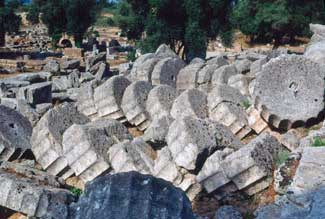 column went up since it would be awfully difficult to get the grooves and arrises (the sharp division between the grooves) right beforehand. There were generally twenty flutes on each column. The earlier columns have a somewhat squat appearance, with a ratio between their height and diameter of 5.5:1 but tend to become slimmer with time, about 6:1. To counteract the optical illusion which makes straight-sided shafts look slightly concave, it became the practice to make the columns bulge somewhat in the middle. This effect is known as entasis and is most pronounced in the earliest examples.
column went up since it would be awfully difficult to get the grooves and arrises (the sharp division between the grooves) right beforehand. There were generally twenty flutes on each column. The earlier columns have a somewhat squat appearance, with a ratio between their height and diameter of 5.5:1 but tend to become slimmer with time, about 6:1. To counteract the optical illusion which makes straight-sided shafts look slightly concave, it became the practice to make the columns bulge somewhat in the middle. This effect is known as entasis and is most pronounced in the earliest examples.
The capital also seems to have developed from wooden forms, presumably simple slabs used as 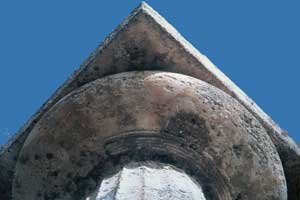 cushions (and to allow the builders to compensate for differences in level from column to column). It consisted of two elements— although they were usually carved from a single block. The echinus is the top part of the shaft. It spreads as it rises to make a smooth transition to the overlying abacus. The junction between the capital and the shaft is normally marked by one or more ‘necking-rings’ (gorgerin) to link the vertical and horizontal elements. The stone beams which made up the architrave had to be kept fairly short— the early builders were uncertain of their load-bearing capacity and the weight they had to support was enormous. Consequently the columns had to be closely spaced. These strong vertical lines deceived the eye into making the sides of the temple appear to sag in the middle. To compensate for this, the architects made the architrave— and the stylobate upon which the columns rested— slightly concave.
cushions (and to allow the builders to compensate for differences in level from column to column). It consisted of two elements— although they were usually carved from a single block. The echinus is the top part of the shaft. It spreads as it rises to make a smooth transition to the overlying abacus. The junction between the capital and the shaft is normally marked by one or more ‘necking-rings’ (gorgerin) to link the vertical and horizontal elements. The stone beams which made up the architrave had to be kept fairly short— the early builders were uncertain of their load-bearing capacity and the weight they had to support was enormous. Consequently the columns had to be closely spaced. These strong vertical lines deceived the eye into making the sides of the temple appear to sag in the middle. To compensate for this, the architects made the architrave— and the stylobate upon which the columns rested— slightly concave.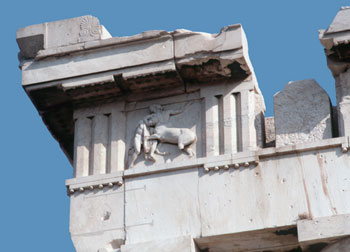
The decorative frieze ran above the architrave to relieve the monotony of the otherwise blank exterior of the temple and was composed of a succession of alternating triglyphs and metopes. The former were carved with three upright bars painted black or dark blue. Beneath each triglyph was a plain band (regula) which was carved on the underside to resemble a series of pegs (guttae)— presumably those used to secure the original wooden version. Because of the close spacing of the colonnade, the earliest builders were able to place each triglyph directly above a column and maintain a sense of balance. But when the gap between columns widened, they had to abandon this principle and place one midway between each. There were also problems at the corners where two triglyphs met and where, in normal circumstances, they had to be placed off-centre. This meant a lot of fine-tuning of the size and spacing of both the frieze and the columns in order to camouflage the effect. Unlike the triglyphs, the metopes were not intended to carry any weight and were used simply to screen the gaps. The ones from Thermum which date to the seventh century BC are merely terra cotta. The panels were decorated with paintings or relief sculpture, often depicting individual episodes from myths related to the god to whom the temple belonged or to the local hero. The background was usually a solid blue or red which made the figures really stand out.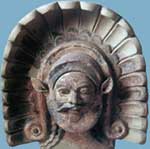
The cornices were essentially terra cotta gutters which overhung the entablature on all four sides of the temple building— also secured by stone guttae. On the short sides, they served as the base of the triangular pediment with slanted (or ‘raking’) cornices forming the other two sides. These gutters were often provided with coloured terra cotta facings (known as antefixes) which were 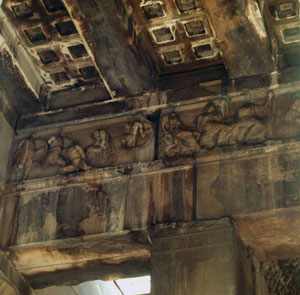 suitably light and could be mass-produced in moulds. The designs, which included running curvilinear and plant motifs, softened the strict geometry of the building itself. They were often provided with stone spouts, preferably in the shape of open mouthed human or animal heads heads.
suitably light and could be mass-produced in moulds. The designs, which included running curvilinear and plant motifs, softened the strict geometry of the building itself. They were often provided with stone spouts, preferably in the shape of open mouthed human or animal heads heads.
The roof was originally made out of fairly light materials such as plaster-covered thatch on a framework of wooden poles and could therefore be quite steep. But with the translation to stone, terra cotta tiles of various types were used and the added weight necessitated a sharp reduction in the pitch. The rafters rested on a framework of horizontal and upright beams— carpentry techniques once again and very unsuited to stone. To reduce the weight the walls and columns had to support, coffered ceilings made up of waffle-like marble slabs were used. The four corners and each gable were decorated with acroteria, often statues made out of light weight terra cotta.
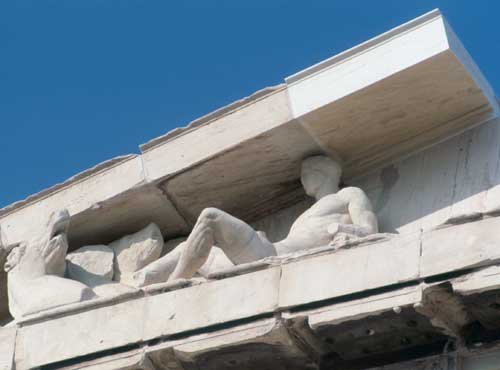
Pedimental sculpture from the Parthenon in Athens
The pediments are the low triangular spaces which form the end gables of the temple and were normally decorated— most often by sculpture in the round. Each pediment frieze was a single composition with the elements adapted to fit the confines of the space. The scenes were all taken straight out of mythology and tended to be rather static and hierarchical. The most important figures were in the centre which the secondary ones flanking them in order of importance.
The Ionic Order
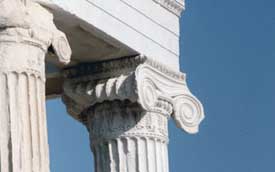 The Ionic Order developed in Asia Minor and the Aegean islands over the period from about 550-450 BC— although many examples can be found on the Greek mainland. The principal differences between it and the Doric lie in the treatment of the columns and the more slender proportions of the whole structure.
The Ionic Order developed in Asia Minor and the Aegean islands over the period from about 550-450 BC— although many examples can be found on the Greek mainland. The principal differences between it and the Doric lie in the treatment of the columns and the more slender proportions of the whole structure.
Ionic capitals consisted of a very narrow echinus surmounted by a scrollwork volute and a relatively small abacus. All of these elements were decorated with increasingly elaborate 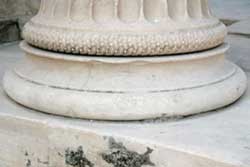 carvings, most often with stylized plant motifs such as rosettes, palmettes, pendant leaves, etc.— all of which would have been brightly and, according to modern tastes at least, garishly painted. The care also much more slender (the ratio of height to diameter is as much as 8:1) and have more extensive and more detailed fluting. Some have as many as 48 grooves (although 24 becomes the standard). The flutes are separated by flat arrises rather than sharp ones. The column bases consist of an upper, convex part known as a torus and a lower, cylindrical part known as a spira.
carvings, most often with stylized plant motifs such as rosettes, palmettes, pendant leaves, etc.— all of which would have been brightly and, according to modern tastes at least, garishly painted. The care also much more slender (the ratio of height to diameter is as much as 8:1) and have more extensive and more detailed fluting. Some have as many as 48 grooves (although 24 becomes the standard). The flutes are separated by flat arrises rather than sharp ones. The column bases consist of an upper, convex part known as a torus and a lower, cylindrical part known as a spira.
